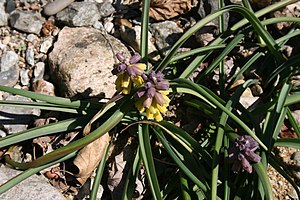Large fruited grape hyacinth
| Large fruited grape hyacinth | ||||||||||||
|---|---|---|---|---|---|---|---|---|---|---|---|---|

Muscari macrocarpum |
||||||||||||
| Systematics | ||||||||||||
|
||||||||||||
| Scientific name | ||||||||||||
| Muscari macrocarpum | ||||||||||||
| Sweet |
The Muscari Macrocarpum ( Muscari macrocarpon ) is a species in the genus of grape hyacinth ( Muscari ) in the family of asparagaceae (Asparagaceae).
description
Vegetative characteristics
The large-fruited grape hyacinth is a perennial herbaceous plant that reaches heights of 12 to 25 cm. This geophyte forms onions as persistent organs. There are three to six basal, ribbon-shaped leaves that are up to 30 cm long and 1 to 1.5 cm wide.
Generative characteristics
In a racemose inflorescence , sterile and fertile flowers stand together. The fertile flowers are yellow with a brown tip and corolla, and blue-violet in the bud . They are (8 to) 10 to 12 mm long, oblong-shaped and have a strong smell of banana. Sterile flowers are purple or absent. The large and winged capsule fruits contain seeds 3 mm in diameter.
The flowering period extends from February to April.
The large-fruited grape hyacinth is diploid with 2n = 18 chromosomes .
Occurrence
This species occurs on the Datça Peninsula (southwest Turkey ) and on the East Aegean islands from Symi to Ikaria and Samos as well as occasionally on the Cyclades ( Amorgos , Donousa ). Statements from Crete are erroneous and refer to the similarly large-fruited Bellevalia sitiaca . The large-fruited grape hyacinth occurs in Phrygana on serpentine and limestone cliffs at altitudes between 10 and 800 meters.
use
The large-fruited grape hyacinth is rarely used as an ornamental plant in rock gardens and borders. She has been in culture since 1601.
Individual evidence
- ↑ a b Eckehart J. Jäger, Friedrich Ebel, Peter Hanelt, Gerd K. Müller (eds.): Exkursionsflora von Deutschland . Founded by Werner Rothmaler. tape 5 : Herbaceous ornamental and useful plants . Springer, Spektrum Akademischer Verlag, Berlin / Heidelberg 2008, ISBN 978-3-8274-0918-8 , pp. 749 .
- ^ A b c Peter Hadland Davis, DH Stuart: Muscari. In: Peter Hadland Davis (Ed.): Flora of Turkey and the East Aegean Islands. Vol. 8 (Butomaceae to Typhaceae) . Edinburgh University Press, Edinburgh 1984, ISBN 0-85224-494-0 , pp. 249 .
- ^ Lund University, Botanical Museum, data at GBIF
- ↑ Zacharias Kypriotakis, Dimitris Tzanoudakis: A new species of Bellevalia from eastern Crete and its confusion with Muscari macrocarpum Sweet. In: Botanica Helvetica. Volume 109, No. 1, 1999, pp. 85-90, DOI: 10.5169 / seals-73288 .
Web links
- Martin Phiippo: Muscaripages. Description of Muscari macrocarpum. ( Memento of May 28, 2012 in the Internet Archive ).
- Robert Sweet, Edwin Dalton Smith: The British flower garden ser. 1 , volume 3, plate 210, 1827, preview in the Google book search (first description and illustration)